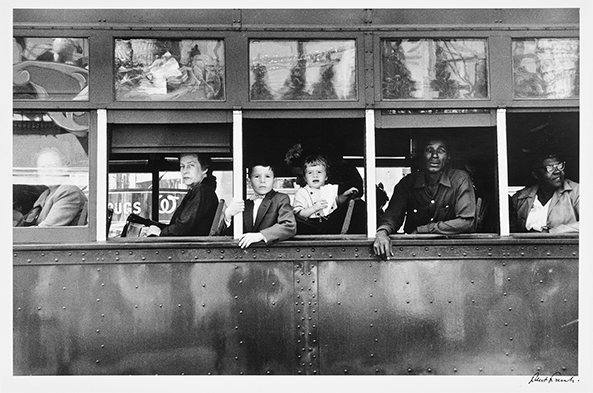Robert Frank: The Americans
Addison Gallery of American Art • Andover, MA • addison.andover.edu • Through April 11, 2021
Robert Frank’s groundbreaking photobook The Americans, published in 1959, not only brought forward new photographic images, it pointed the way toward new photographic imaginations. The U.S. edition shed the 1958 French edition’s sociological commentaries and, as Frank wanted, offered no theory, just an image on the right facing its barebones identifying caption on the left: Bank—Houston, Texas; Elevator—Miami Beach. Each tells a cinematic story, offering a frame captured from America’s constant flow of existence and experience. Arranged into propulsive, rhythmic unity, each image holds the eye even as it creates anticipation for the next. The tattered flag of Fourth of July—Jay, New York precedes the bookended harshness and despair of segregation in Trolley—New Orleans, followed by a welter of motion and emotion—joy, determination, suspicion, anxiety—in Canal Street—New Orleans. Open to both poverty and indulgence, grit and melancholy, sorrow and humor, the book perplexed early critics, who couldn’t decide if it was an indictment or a paean.
This exhibition deconstructs the iconic text into its 83 separate images, maintaining Frank’s carefully choreographed juxtapositions and spare captioning. The Addison has generously made the exhibit accessible online for those keeping at a remove from the risk of coronavirus contagion. Engagement with The Americans inevitably suffers in the high-tech Matterport rendering, however, which requires adjustment for each image, attenuating impact, intimacy, and immediacy. All the more reason to venture to the gallery in person if you’re comfortable doing so.

Frank had mostly given up street photography when the book came out. Reading like a series of film cells without sprocket holes, the main image area of Trolley—New Orleans, the text’s cover image, indicated his next career: filmmaker. Of his once infamous book, Frank wrote, “The view is personal.” Yet spontaneous as its images are, some, like Bar—Las Vegas, Nevada, capture luminous and introspective moments. As photographer Todd Papageorge described the cumulative effect: “a continent is spanned, but its life compressed in a single grief.” Following a rough political season and prolonged period of suffering and death, looking, thinking, and feeling through Frank’s Americans provides a welcome balm.
—Susan Boulanger
